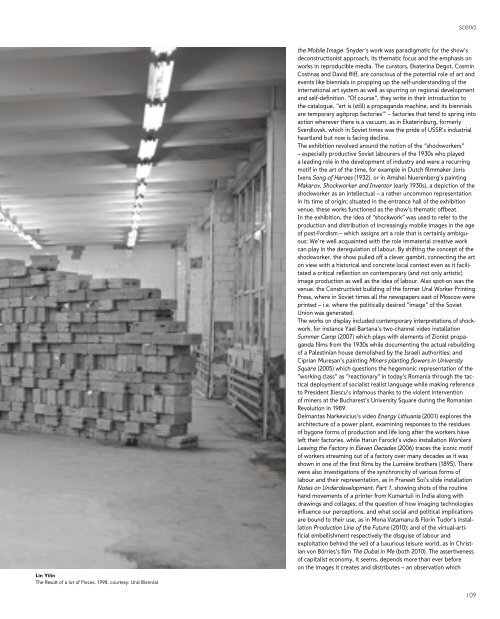Create successful ePaper yourself
Turn your PDF publications into a flip-book with our unique Google optimized e-Paper software.
scena<br />
Lin Yilin<br />
The Result of a lot of Pieces, 1998, courtesy: Ural Biennial<br />
the Mobile Image. Snyder’s work was paradigmatic for the show’s<br />
deconstructionist approach, its thematic focus and the emphasis on<br />
works in reproducible media. The curators, Ekaterina Degot, Cosmin<br />
Costinaø and David Riff, are conscious of the potential role of art and<br />
events like biennials in propping up the self-understanding of the<br />
international art system as well as spurring on regional development<br />
and self-definition. “Of course”, they write in their introduction to<br />
the catalogue, “art is (still) a propaganda machine, and its biennials<br />
are temporary agitprop factories” 1 – factories that tend to spring into<br />
action wherever there is a vacuum, as in Ekaterinburg, formerly<br />
Sverdlovsk, which in Soviet times was the pride of USSR’s industrial<br />
heartland but now is facing decline.<br />
The exhibition revolved around the notion of the “shockworkers”<br />
– especially productive Soviet labourers of the 1930s who played<br />
a leading role in the development of industry and were a recurring<br />
motif in the art of the time, for example in Dutch filmmaker Joris<br />
Ivens Song of Heroes (1932), or in Amshei Nuerenberg’s painting<br />
Makarov, Shockworker and Inventor (early 1930s), a depiction of the<br />
shockworker as an intellectual – a rather uncommon representation<br />
in its time of origin; situated in the entrance hall of the exhibition<br />
venue, these works functioned as the show’s thematic offbeat.<br />
In the exhibition, the <strong>idea</strong> of “shockwork” was used to refer to the<br />
production and distribution of increasingly mobile images in the age<br />
of post-Fordism – which assigns art a role that is certainly ambiguous:<br />
We’re well acquainted with the role immaterial creative work<br />
can play in the deregulation of labour. By shifting the concept of the<br />
shockworker, the show pulled off a clever gambit, connecting the art<br />
on view with a historical and concrete local context even as it facilitated<br />
a critical reflection on contemporary (and not only artistic)<br />
image production as well as the <strong>idea</strong> of labour. Also spot-on was the<br />
venue, the Constructivist building of the former Ural Worker Printing<br />
Press, where in Soviet times all the newspapers east of Moscow were<br />
printed – i.e. where the politically desired “image” of the Soviet<br />
Union was generated.<br />
The works on display included contemporary interpretations of shockwork,<br />
for instance Yael Bartana’s two-channel video installation<br />
Summer Camp (2007) which plays with elements of Zionist propaganda<br />
films from the 1930s while documenting the actual rebuilding<br />
of a Palestinian house demolished by the Israeli authorities; and<br />
Ciprian Mureøan’s painting Miners planting flowers in University<br />
Square (2005) which questions the hegemonic representation of the<br />
“working class” as “reactionary” in today’s Romania through the tactical<br />
deployment of socialist realist language while making reference<br />
to President Iliescu’s infamous thanks to the violent intervention<br />
of miners at the Bucharest’s University Square during the Romanian<br />
Revolution in 1989.<br />
Deimantas Narkevicius’s video Energy Lithuania (2001) explores the<br />
architecture of a power plant, examining responses to the residues<br />
of bygone forms of production and life long after the workers have<br />
left their factories, while Harun Farocki’s video installation Workers<br />
Leaving the Factory in Eleven Decades (2006) traces the iconic motif<br />
of workers streaming out of a factory over many decades as it was<br />
shown in one of the first films by the Lumière brothers (1895). There<br />
were also investigations of the synchronicity of various forms of<br />
labour and their representation, as in Praneet Soi’s slide installation<br />
Notes on Underdevelopment. Part 1, showing shots of the routine<br />
hand movements of a printer from Kumartuli in India along with<br />
drawings and collages; of the question of how imaging technologies<br />
influence our perceptions, and what social and political implications<br />
are bound to their use, as in Mona Vatamanu & Florin Tudor’s installation<br />
Production Line of the Future (2010); and of the virtual-artificial<br />
embellishment respectively the disguise of labour and<br />
exploitation behind the veil of a luxurious leisure world, as in Christian<br />
von Börries’s film The Dubai in Me (both 2010). The assertiveness<br />
of capitalist economy, it seems, depends more than ever before<br />
on the images it creates and distributes – an observation which<br />
109














